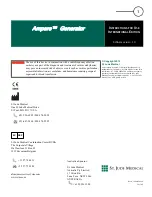
9
Ampere™ Generator Instructions for Use
International Edition Rev. A 100081509-en
Precautions
CAUTION:
While using an irrigated catheter, the temperature displayed on the Ampere™ Generator is the temperature of the cooled
electrode at the tip of the catheter—
not the tissue temperature
.
CAUTION:
Always verify that the tubing and catheter have been properly cleared of air prior to inserting the catheter into the
vasculature since entrapped air bubbles may cause emboli. Also, inspect IV tubing for sufficient continuous flow prior
to its use as non-continuous flow may lead to coagulation within and around the distal electrode resulting in blockage of
irrigation ports.
CAUTION:
Peri-procedural anticoagulation therapy is recommended for patients undergoing left-sided and transeptal cardiac
procedures and should be considered for selected patients undergoing right-sided procedures.
CAUTION:
The catheter impedance display of the Ampere™ Generator should be continuously monitored during RF power delivery.
If a sudden rise in impedance is noted, power delivery should be discontinued. The catheter should be removed, and the
distal tip of the catheter should be evaluated and cleaned (if necessary) to eliminate any coagulum.
CAUTION:
Do not immerse cable connectors in fluids; electrical performance could be adversely affected.
CAUTION:
Adequate filtering must be used to allow continuous monitoring of the surface electrocardiogram (ECG) during
radiofrequency power applications. Monitoring systems incorporating high-frequency current-limiting devices are
recommended.
CAUTION:
Desired ablation parameters must be set by the user; otherwise, the default values will be used.
CAUTION:
Choose the lowest possible output power for the intended purpose.
CAUTION:
Read and follow the DIP electrode manufacturer’s instructions for use.
CAUTION:
Standard grounding procedures should be followed if electrosurgical instruments are used.
CAUTION:
The Ampere™ Generator is capable of delivering significant electrical power. Patient or operator injury can result from
improper handling of the catheter and DIP electrode, particularly when operating the device. During power delivery, the
patient should not be allowed to come in contact with grounded metal surfaces. This can be achieved by placing a non-
conductive material between the patient and the grounded metal surfaces. DIP electrode attachments are to be as close
to the operating field as possible.
CAUTION:
Position connecting cables in such a manner that contact with patient or other leads is avoided.
CAUTION:
Accessory equipment connected to the analog and digital interfaces must comply with the respective IEC standards (IEC
60950 for data-processing equipment and IEC 60601-1 for medical equipment). Additional equipment connected to the
signal input or output connections comprise a medical system and therefore, must comply with the requirements of IEC
60601-1-1.
CAUTION:
Apparent low-power output or failure of the equipment to function correctly at normal settings may indicate faulty
application of the DIP electrode or failure of an electrical lead. Do not increase the power before checking for obvious
defects or misapplication.
CAUTION:
Use non-flammable agents for cleaning and disinfecting.
CAUTION:
Placement must allow adequate airflow around the unit for cooling.
CAUTION:
Regularly inspect and test reusable cables and accessories.
CAUTION:
Do not connect items which are not specified as part of system.



















